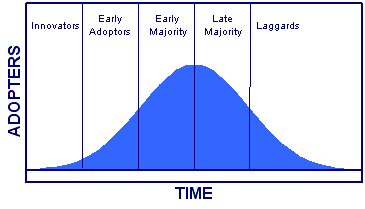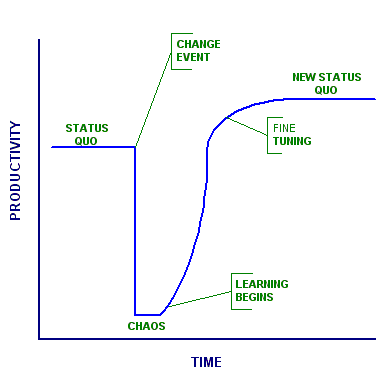People often talk about resistance to change at an individual level. While this is a real phenomenon, there are systemic issues that cause an aversion to change as well.
If we think of the status quo as inertia, then we realize that there is a mass at rest, so to speak, and that a controlled application of force is required in order to move ahead.
Systemic inertia is caused by many variables that include the level of investment in the status quo, technology adoption, learning curves, opportunity costs and so on. The purpose of this article will be to discuss some of these facets at a high-level.
Total Investment
Without a doubt, systems cost an organization both in terms of time and money. The larger and more complex a system is, coupled with the number of users, then the larger the total investment, both initially and over time. The investment in a system, or any technology for that matter, happens both at organizational and even personal levels. As this level of investment increases, the ease of change decreases.
There are a variety of reasons for this, including risk aversion at an organizational level. Some examples include: a desire to maximize the current investment, not wanting a depreciation hit from the residual book value of the current system, not wanting to increase assets on the balance sheet and thus affect return on assets, and so on.
Furthermore, in times of tight capital markets, attaining capital to replace an existing system becomes quite a challenge. This is one of the many reasons why business cases that attempt to justify change must set forth tactical and strategic justifications that take both organizational and stakeholder concerns into account.
Organizations are not the only entities with investments in a current platform. Users have an investment as well in terms of their time and learning the system. For example, if a user has spent five years using a system, then he/she has likely become very proficient at using the system to achieve his/her job goals.
Now, if the system changes, not only must the user take the time to learn the new system, but meeting objectives set forth at an earlier date using the old system comes to the foreground. Those goals were likely set without the system change taken into account. With this in mind, the user may have issues and potentially lose a bonus or even employment.
Definitely, organizations and users both have investments. At a high level, let’s step back and look at some of the other potential factors that create inertia that must be overcome in order to move forward.
Users and Technology Adoption
In general, at least with software, as user counts increase, then the costs in regards to licensing, training and support all rise accordingly. This relationship between headcount and costs is readily understood. However, bear in mind that the users are apt to have very different views about the technology.
Statistically, users fall into a bell-curve of technology adoption. You have people ranging from those who always want to try the latest technology no matter what to those who adopt only because they have no other choice. Training and support costs can increase disproportionately as increasingly change-averse people are on-boarded to the new system.

Pervasiveness
An additional consideration is that many systems are modular. For example, a large ERP system may contain hundreds of modules that are used across the organization. Thus, the gestalt of the investment and adoption issues often does not occur in isolation. They occur across functional areas and down through the layers of the organization.
To illustrate, purchasing may be thrilled by the idea of moving to a new ERP system whereas the receiving and warehousing functions are not because their headcounts and budgets will be cut. Thus, systemic impacts must be considered. It is very risky, even foolhardy, to look at a change in isolation without taking overall effects into account.
Learning Curve
One area that is often overlooked in the justification for change is the impact to the organization’s productivity during the course of the change. A sigmoid curve is often used to show the effects of a change and the resulting impacts on productivity. The following is an illustration:

Essentially, you have the status quo represented by a flat line, something changes and the organization is thrown into chaos and productivity plummets. As learning commences, productivity begins to climb and finally levels out at a new status quo.
Note, the graphic illustrates a positive increase in productivity but in reality, the change could result in a negative, neutral or positive new level of productivity. From a cost perspective, note that from when the change event triggers the plunge into chaos until the new status quote is reached, productivity fell and costs were incurred. This cost and the factors that can reduce or increase it must be taken into account.
To digress, organizational learning is a fascinating topic because in this era competition is based on the ability to acquire and integrate knowledge faster than the competition. Any change results in a learning curve effect. The curve may take 10 seconds to complete or 10 weeks. The duration depends on the organization’s culture, the users and their knowledge and experience.
Effective project management that takes the learning curve into account develops mitigating strategies to accelerate movement through the learning curve is key. Some organizations and users will be nervous, terrified even, of change due to the resulting disruption.
However, this can be minimized, but not eliminated, through planning and appropriate stakeholder involvement. In the end, there will be an impact to productivity that must be considered during the business case justification of a system.
Opportunity Costs
Organizations, whether for profit or not, have both an internal and external competition for resources. Internally, there typically is a constant competition for labor and budgets. Thus, an investment in one area means that there will not be an investment in another area.
In other words, picking one project will have an opportunity cost associated with not being able to proceed with other projects due to scarce resources. This zero-sum gain means that investments must be carefully selected to maximize results. Changing from a current system to a new one will require a solid business case, careful oversight and the results should be measured.
Summary
Change requires that inertia at organizational and stakeholder levels must be identified and overcome. There are many factors that can affect the speed of change. On one hand, parties attempting to gain approval for a replacement system must be very aware of the tactical and strategic needs of the organization and develop a solid business case accordingly. On the other hand, management must be aware of customer and capital market trends and approve projects that fulfill both short and long-term needs.
Inertia will always exist; the key is to understand what it comprised of and what must be done in order to overcome it.
Huawei’s AI Update: Things Are Moving Faster Than We Think
FEATURE | By Rob Enderle,
December 04, 2020
Keeping Machine Learning Algorithms Honest in the ‘Ethics-First’ Era
ARTIFICIAL INTELLIGENCE | By Guest Author,
November 18, 2020
Key Trends in Chatbots and RPA
FEATURE | By Guest Author,
November 10, 2020
FEATURE | By Samuel Greengard,
November 05, 2020
ARTIFICIAL INTELLIGENCE | By Guest Author,
November 02, 2020
How Intel’s Work With Autonomous Cars Could Redefine General Purpose AI
ARTIFICIAL INTELLIGENCE | By Rob Enderle,
October 29, 2020
Dell Technologies World: Weaving Together Human And Machine Interaction For AI And Robotics
ARTIFICIAL INTELLIGENCE | By Rob Enderle,
October 23, 2020
The Super Moderator, or How IBM Project Debater Could Save Social Media
FEATURE | By Rob Enderle,
October 16, 2020
FEATURE | By Cynthia Harvey,
October 07, 2020
ARTIFICIAL INTELLIGENCE | By Guest Author,
October 05, 2020
CIOs Discuss the Promise of AI and Data Science
FEATURE | By Guest Author,
September 25, 2020
Microsoft Is Building An AI Product That Could Predict The Future
FEATURE | By Rob Enderle,
September 25, 2020
Top 10 Machine Learning Companies 2020
FEATURE | By Cynthia Harvey,
September 22, 2020
NVIDIA and ARM: Massively Changing The AI Landscape
ARTIFICIAL INTELLIGENCE | By Rob Enderle,
September 18, 2020
Continuous Intelligence: Expert Discussion [Video and Podcast]
ARTIFICIAL INTELLIGENCE | By James Maguire,
September 14, 2020
Artificial Intelligence: Governance and Ethics [Video]
ARTIFICIAL INTELLIGENCE | By James Maguire,
September 13, 2020
IBM Watson At The US Open: Showcasing The Power Of A Mature Enterprise-Class AI
FEATURE | By Rob Enderle,
September 11, 2020
Artificial Intelligence: Perception vs. Reality
FEATURE | By James Maguire,
September 09, 2020
Anticipating The Coming Wave Of AI Enhanced PCs
FEATURE | By Rob Enderle,
September 05, 2020
The Critical Nature Of IBM’s NLP (Natural Language Processing) Effort
ARTIFICIAL INTELLIGENCE | By Rob Enderle,
August 14, 2020

Datamation is the leading industry resource for B2B data professionals and technology buyers. Datamation's focus is on providing insight into the latest trends and innovation in AI, data security, big data, and more, along with in-depth product recommendations and comparisons. More than 1.7M users gain insight and guidance from Datamation every year.
Advertise with TechnologyAdvice on Datamation and our other data and technology-focused platforms.
Advertise with Us
Property of TechnologyAdvice.
© 2025 TechnologyAdvice. All Rights Reserved
Advertiser Disclosure: Some of the products that appear on this
site are from companies from which TechnologyAdvice receives
compensation. This compensation may impact how and where products
appear on this site including, for example, the order in which
they appear. TechnologyAdvice does not include all companies
or all types of products available in the marketplace.